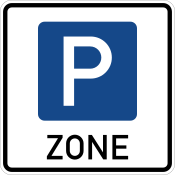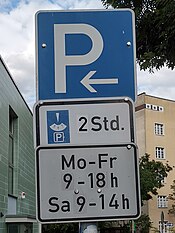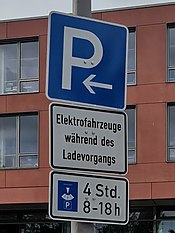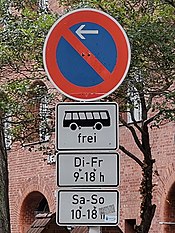Proposal:Parking conditions on separately mapped parking areas
| parking conditions on separately mapped parking areas | |
|---|---|
| Proposal status: | Obsoleted (inactive) |
| Proposed by: | Supaplex030 |
| Draft started: | 2022-07-30 |
| This page/discussion/proposal has become obsolete due to the complete revision of the parking lane schema. |
Problem/Rationale
There is the question of how parking restrictions/conditions are mapped correctly on separately mapped parking areas adjacent to the street (parking=street_side, parking=lane). While there is an established tagging for parking mapped on the highway line (parking:condition=*) and for parking areas in general (access=*, fee=*, maxstay=*, ...), there is no comparable documentation for separately mapped parking areas yet.
Obviously there are two different tagging schemes that exist in parallel that could be applied to street side parking. This is an unfavourable situation that we can accept and document pragmatically or that we can resolve fundamentally. The case of the street-side parking areas shows the flaws of the parking:lane=* scheme, which differs from common conventions and schemes, e.g. regarding namespacing or the use of access tags (the conditional problem has already been addressed recently).
There seem to be these possible solutions for tagging parking restrictions on street level parking:
- We use the established tags for parking lots also on street-side parking areas (access=*, fee=*, maxstay=*... and their conditional restrictions).
- We adopt the parking:condition=*-scheme for street-side parking areas.
- We fundamentally resolve this conflict by adopting the common OSM access scheme to the parking:lane/condition scheme.
But which one do we choose?
Pros and Cons
- access=*, fee=* and maxstay=* are the "vanilla" tags that are also used in many other contexts in OSM. The parking:condition=*-scheme use it's own tag system that is not compatible with "vanilla" tagging.
- But parking:condition=* tagging is well established and widely used and therefore the standard for parking on streets.
- Both variants can map most cases well, with individual weaknesses (e.g. access=* tagging cannot distinguish between
no_stoppingandno_parkingwithout establishing a new tag). - The parking:condition variant on areas would be compatible with mapping parking lanes as linear features. The access/fee/maxstay variant would be consistent with mapping other parking areas.
- If the parking:condition variant is used, access/fee/maxstay tags would be redundant and have to remain empty, which might confuse users and evaluators or be interpreted as missing data. If both variants are used together, data would be collected twice and could be contradictory.
- The fundamentally harmonisation variant would require a challenging, deep renewal of the parking:lane=* scheme (including the deprecation of the parking:condition=* scheme) and all applications that depend on it. It's unclear whether this effort and its consequences is in reasonable balance with its benefits.
Examples
This table illustrates typical examples (at the moment only from Berlin/Germany) for all variants. It's only intended to provide an orientation/for illustrating the differences. Note, however, that the tagging and the tags themselves might still need to be discussed in individual cases.
| Description | Image | Linear Features (highway=* + parking:lane:<side>=*) | Area Features (amenity=parking + parking=street_side/lane)
| ||
|---|---|---|---|---|---|
| using parking:condition (= current status quo) |
using access/fee/maxstay (= fundamentally harmonisation variant) |
(parking:condition variant) (= variant 2/parking:condition variant) |
(access/fee/maxstay variant) (= variant 1/access/fee/maxstay variant) | ||
| Free Parking
There are no conditions/restrictions for parking. |
parking:condition=free |
||||
| Temporary no parking
There is no parking at specific, designated hours. Example: There is a no-stopping sign from Monday to Friday between 08:00 and 18:00. |

|
parking:condition:<side>=free |
parking:lane:<side>:access=yes |
parking:condition=free |
access=yes |
| Residential or ticket parking zone
Residents get parking permits, parking for non-residents allowed with ticket. Example: Residential permit for „Zone 60“ or ticket needed from 09:00-22:00, free at night and on sundays. |

|
parking:condition:<side>=ticket;residents |
parking:lane:<side>:access=yes |
parking:condition=ticket;residents |
access=yes |
| Parking only for residents
Residents get parking permits, but nobody else is allowed to park here. Example: Residential permit for „Zone 60“ or ticket needed from 09:00-22:00, free at night and on sundays. |
 
|
parking:condition:<side>=residents |
parking:lane:<side>:access=private |
parking:condition=residents |
access=private
|
| Disc parking
Parking is allowed for a maximum of a designated period of time (the start time is usually recorded with a parking disc in the vehicle). Example: From Monday to Friday between 09:00 to 18:00 and on Saturdays between 09:00 to 14:00 parking is allowed for a maximum of two hours. |

|
parking:condition:<side>=free |
parking:lane:<side>:access=yes |
parking:condition=free |
access=yes |
| Charging electric vehicles
Parking for charging electric vehicles. Example: Parking only allowed for vehicles during charging. Between 08:00 and 18:00, the maxstay time period is 4 hours. |

|
parking:condition:<side>=charging |
parking:lane:<side>:access=no |
parking:condition=charging |
access=no |
| Loading zone
Parking is not allowed, but standing for loading or unloading is explicitly designated. Example: Vehicles are not allowed to stop, but "loading and unloading" as well as "getting in and out" is explicitly allowed. |

|
parking:condition:<side>=loading |
parking:lane:<side>:access=yes |
parking:condition=loading |
|
| Parking for specific vehicles only
Parking is only allowed for vehicles of a certain type. Example: Parking only allowed for motor cars. |

|
parking:lane:<side>:access=no |
|||
| Parking for specific vehicles only (temporary)
At certain times, parking is only permitted for vehicles of a certain type. Example: Only buses are allowed to park during the designated times. |

|
parking:condition:<side>=free |
parking:lane:<side>:access=yes |
parking:condition=free |
access=yes |
| Taxi waiting area
A waiting area for taxis where other vehicles are not allowed to stop. |

|
parking:condition:<side>=no_stopping |
parking:lane:<side>:access=no |
parking:condition=no_stopping |
|
| Disabled parking
A public parking area reserved for people with a disability. Example: The parking area is reserved for people with disabilities on weekdays between 06:00 and 17:00. |

|
parking:condition:<side>=free |
parking:lane:<side>:access=yes |
parking:condition=free |
access=yes |
| Individual permission parking
Parking only allowed with an individual parking permit (e.g. given to people with disabilities). Example: A marked parking area is reserved only for the owner of a parking permit with a specific number. (Note: This permit is not "routinely granted to everyone requesting it", so don't use |

|
parking:condition:<side>=private |
parking:lane:<side>:access=private |
parking:condition=private |
|
| Parking on kerb
The vehicle must be parked on, or half on, or beside the carriageway. Example: Parking on kerb is designated, but no other conditions or fees. |

|
parking:lane:<side>=perpendicular |
parking:lane:<side>=perpendicular |
amenity=parking |
amenity=parking |
Open Questions
- Which variant should be recommended and documented?
- How to map exclusive parking areas for car sharing vehicles? parking:condition:<side>=car_sharing / car_sharing=designated (+ access=customers?)
External discussions
- Thread on the Tagging Mailing List about this variants and which should be preferred
- Discussions on approved Parking lane conditional proposal, in particular "counter-proposal" by User:Kovposch